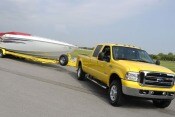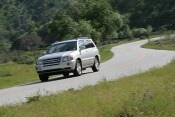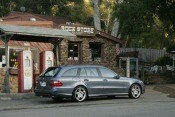Whether you're heading out on a weekend road trip, planning a month-long family vacation or waking a four-wheeled friend from its long winter's nap, you'll want to make sure the summer driving season brings maximum enjoyment and minimum stress. Before you pack up the car, check out these travel tips from our staff of road warriors.
-
1. Tend to your tires.
Exchange your winter tires for summer or all-season tires. Winter tires wear out quickly on dry, hot pavement; switching them early will keep them in optimum shape for next year, not to mention improve your car's handling during the summer months.
Check your tire pressure — and check it often. With every passing month, the average tire loses about a pound of air pressure. Proper tire inflation is critical to achieving the best possible contact between the tire and the road and avoiding blowouts and tread separation. Most cars have a decal mounted in their driver doorjamb that lists the correct tire pressures depending on tire size and vehicle load. Properly inflated tires will also improve fuel economy, particularly important if you're doing lots of high-speed driving on a long family vacation.
2. Stay on top of your fluids.
If you've fallen behind on maintenance, get your car's oil changed before you hit the road. Keep in mind that any of today's oils, including 5W-30, 10W-30 or 10W-40 grades, are multiviscous, and get a bit thinner the hotter it gets outside, thereby increasing the chance that the engine might not get the proper lubrication (it's the opposite in winter). Your vehicle's owner's manual will list the manufacturer's oil recommendations for different climates. If you have a dealership or local garage perform the oil change, ask the manager what type and viscosity of oil they are putting into your vehicle. Consider changing it to a compound that's slightly thicker if you're going to be driving in extreme temperatures. While the hood is up, check the coolant/antifreeze mixture inside your vehicle's radiator. The ideal ratio of coolant to water is 50-to-50 for optimal temperature regulation in both cold weather and hot. You can check this with a simple and inexpensive antifreeze tester, which you can find at all auto parts stores.

3. Give the rest of your car a once-over.
Inspect the belts and hoses. In modern cars, they are designed to last a long time, but still have the potential to fail. Before summer begins, have the belts and hoses inspected by a mechanic. And if your car is at least a couple of years old and you're not sure when they were last replaced, consider having them changed, especially before setting out on a long road trip.
Inspect the wiper blades. The life expectancy of a wiper blade is just one year, and wipers often get dried out or chewed up during a hard winter. If yours are not making full contact with the windshield, replace them. Also, keep an eye on your windshield washer fluid reservoir, which you can top off in less time than it takes to fill your tank with gas.
Finally, check the battery. Extreme heat and cold put additional strain on an automobile battery, particularly older ones. If yours is more than 3 years old, have it tested at a certified automotive repair facility. If you don't know how old it is, think about replacing it. This may seem like an unnecessary expense — especially for those on tight budgets — but trust us, it's better than trying to find a replacement battery while you're stuck on the side of the road with three screaming kids.
4. Prepare an emergency kit for your car.
Here's what we recommend carrying in a safe, secure part of your trunk or cargo area:
1. A flashlight, flares and a first-aid kit
2. Jumper cables
3. A mat or blanket to protect your clothing in the event that you need to change a tire or reach debris that might be lodged underneath your vehicle
4. Extra clothes and gloves
5. Paper towels
6. Extra washer fluid
7. Nonperishable food
8. Jug of water
9. Basic tools (wrenches, ratchet/socket set, screwdrivers, pliers or Vise-Grips, etc.)
Many of these items are available (often prepackaged) at auto parts stores or major department stores. Also, keep the phone number for your emergency roadside assistance program, if you have one, in a convenient location.

5. Pack smart.
Many of us are guilty of taking everything but the bathtub with us on road trips — stuffing our vehicles to the roof with pillows, coolers, suitcases, CDs, etc. — to the detriment of the vehicle's comfort, handling and outward visibility. Our advice: bring only what's necessary.
In the days before you leave, then, make a list of what you'll need on your trip, and pack as many of those things ahead of time as possible instead of throwing everything in the car in a panic at the last minute. Ask yourself: do you have to bring shampoo when it will be provided by your hotel? Can you afford to eat some meals along the way instead of packing up the entire pantry? Do you really need to bring eight pairs of shorts when you'll have access to Grandma's washer/dryer?
That said, we do recommend packing a small cooler with bottled water, crackers, cereal bars, fruit, etc., to keep you and your family hydrated and hunger-free. Replenish these supplies at gas stations or rest stops. Try to avoid salty foods and sodas, as they can actually make you thirstier. And don't stuff yourself when you eat; food comas at 70 miles per hour are not good, to say the least. And don't forget a camera. If you're traveling with small children, check out Top 10 Family Road Trip Must-Haves.
6. Load smart.
Once you've decided what to bring, don't pack items so high that they completely block your outward vision. Don't bury items that you may need to access at a rest stop. If possible, even out your load from side to side, and if you're hauling something in a pickup or SUV, try to keep the heaviest items as close to the center of the vehicle as possible for optimal handling. And make sure you don't exceed your vehicle's payload limit.
Another travel tip rarely considered by vacationers is having your headlights adjusted slightly downward when carrying a heavy load in the cargo area. Unless you have a self-leveling suspension, this could cause the rear of the vehicle to sag, directing your headlights high enough to blind oncoming traffic and irritate drivers you may be following at night. This is especially important in the case of trucks and SUVs, whose headlights are mounted quite high on the vehicle in the first place. Rule of thumb: if the reflective highway signs are particularly bright, or if you can see the hair color of drivers in the car in front of you, your headlights need to come down. Check your owner's manual to find out how to do this.

7. Avoid fatigue.
Drowsy driving is one of the leading causes of highway accidents. There are a few measures you can take to avoid getting tired on the road. Make absolutely sure you get a good night's rest before spending a long time behind the wheel. Be mindful of caffeine; a short-term coffee buzz will be followed by a lull, and it's all but impossible to sustain one's energy for hours on end. Switch drivers every hour or two if you can. If you find yourself getting tired, by all means pull over at a safe spot, switch on your hazard lights and rest for a few minutes. Finally, stop often. Some people complain about having small bladders, but frequent bathroom stops actually help lower the risk of freeway fatigue. Besides, you never know what cool trinkets, local vittles and photo ops may be waiting for you in those random small towns you might otherwise skip over.

8. Tow, tow, tow your boat (or any trailer) with safety in mind.
Keep it slow, keep it smooth. When towing, everything you do while driving needs to be done at significantly reduced speed when compared to driving without a trailer. Smoothness and caution are paramount to successful trailering, including accelerating, turning, changing lanes and especially braking. Plan all maneuvers well ahead of time and be especially cautious when towing a slab-sided trailer in windy conditions. Also, familiarize yourself with trailering-specific traffic laws and heed reduced speed limits.
Make sure that you have generously sized and properly located mirrors that allow you to see what's next to your vehicle and trailer. Install mirror extensions if necessary.
Check your owner's manual to make sure your vehicle is properly equipped to handle a trailer hitch, and that it can handle the tongue weight and load of the trailer you intend to pull. Also, do not overload your vehicle's trunk or cargo area, as that can put additional strain on the rear suspension and other components.
If you're new to towing, don't attempt it until you've read about how to do it.

9. Take the scenic route.
Life really is about the journey, so for Pete's sake, have some fun on your trip. If you're particularly confident in your navigator (or navigation system), consider taking the more picturesque side roads instead of broad, mind-numbing interstates that may be packed with big rigs and holiday travelers. Pad your trip with extra time so that you can stop at historical landmarks, soak in the beauty of natural landmarks or enjoy a picnic.

10. Be nice.
While the high costs of gasoline may keep some families off the road this year, you'll probably encounter quite a few fellow road-trippers anyway. But consider this: you're tired, they're tired, and highway driving (especially with little ones) can shorten our collective fuses, making road rage all too common on our interstates. Some words to the wise: be nice. Use your signals. Let faster drivers pass. Don't tailgate. Be patient with trucks and vacationing families in RVs. They have a right to the road, too, and if we all can just learn to get along, the road can be an awfully fun place to spend time.
If you keep these travel tips in mind, you're well on your way to a relaxing and enjoyable summer road trip season.